Technology has successfully miniaturized electronic components and structures down to a billionth of a meter. When engineering these nano-components, having an understanding of phonon properties is essential.
Mapping phonons, a quantum of energy quasiparticle associated with compressional waves, in nanostructures is essential for developing and understanding thermal nanodevices, modulating thermal transport, and engineering innovative nanostructured thermoelectric materials. In ordered crystal structures, phonon waves of atomic displacements usually carry thermal energy equal to the crystal’s atomic vibrational frequency.
By engineering complex structures including alloys, nanostructures, and superlattice interfaces, researchers can tailor thermal conductivity through controlled phonon propagation, while preserving electrical conductivity. Abrupt structural changes in nanostructures, for instance, can achieve high phonon impedance, lowering conductivity.
Investigating Phonon Behavior
Using a germanium-silicon alloy, researchers from UC Irvine’s Irvine Materials Research Institute (IMRI), the Massachusetts Institute of Technology (MIT), and other institutions were able to investigate phonon behavior in the disordered environment of quantum dots. These environments include the interface between the quantum dot and the surrounding silicon, as well as near the dome-shaped surface of the quantum dot nanostructure itself.
Quantum dots are semiconductor particles only a few nanometers in size that exhibit optical and electronic features different from larger particles, as a result of quantum mechanical effects. They remain a key focus in nanotechnology and materials science.
Using a Nion UltraSTEM 200 scanning transmission electron microscope (STEM), the team designed a new method to map phonons in crystal lattices at atomic resolution. They used vibrational electron energy loss spectroscopy (EELS) in the STEM to probe the dynamic behavior of phonons next to a single silicon-germanium dot. Probing this behavior revealed the distribution of photons at the interfaces of Si/SiGe (silicon-germanium heterostructure) quantum dots. EELS is a method that uses high spatial resolution to measure molecular bonding environments.
We developed a novel technique to differentially map phonon momenta with atomic resolution, allowing us to observe nonequilibrium phonons that only exist near the interface.
Dr. Xiaoqing Pan, UCI Professor of Materials Science and Engineering, and Physics, Henry Samueli Endowed Chair in Engineering, and IMRI Director.
IMRI has an extensive range of cutting-edge, open-access user facilities for characterizing inorganic, organic, and biological materials and devices, spanning sub-angstrom to macroscopic scales. These resources are available to researchers across academia, industry, and non-profit organizations.
The collaborative work expanded the understanding of heat transport via quantum dots and engineered nanostructures in electronic components. At the atomic scale, heat is transported in solid materials as a wave of atoms that have been moved from their equilibrium position as heat shifts away from a thermal source.
This work marks a major advance in the field because it is the first time we have been able to provide direct evidence that the interplay between diffusive and specular reflection largely depends on the detailed atomistic structure.
Dr. Xiaoqing Pan, UCI Professor of Materials Science and Engineering, and Physics, Henry Samueli Endowed Chair in Engineering, and IMRI Director.
Isolating Vibrations from the Nion UltraSTEM 200
UC Irvine began the development of a world-class electron microscopy facility to house the most sensitive transmission electron microscopes (TEMs) available, while accommodating next-generation instruments anticipated in the coming decades. To achieve this, in 2015, existing ground-floor engineering classrooms were converted to establish the IMRI within the UCI Samueli School of Engineering.
To minimize noise and vibration, each instrument room slab was physically isolated from existing structural elements and adjacent new walls.
In IMRI's STEM-1 room, a custom vibration isolation platform was installed to further minimize the vibrations experienced by the lab's Nion UltraSTEM 200. The platform enables distortion-free imaging at magnifications down to sub-angstrom levels—smaller than the width of an atom.
Additional preparation for the Nion UltraSTEM included recessing the vibration isolation platform, allowing the front section of the Nion to be rolled on and off for accessibility and servicing when not in operation.
IMRI used a Negative-Stiffness vibration isolation platform, manufactured by Minus K Technology (Minus K), for the Nion UltraSTEM 200.
Negative-Stiffness Vibration Isolation
Negative-Stiffness vibration isolators are compact, require no electricity or compressed air, and contain no motors, pumps, or chambers. With no components subject to wear, maintenance requirements are eliminated. Operation occurs entirely through a passive mechanical mode.
Vertical-motion isolation is provided by a stiff spring that supports a weight load, combined with a negative-stiffness mechanism.
Erik Runge, Vice President of Engineering for Minus K.
"The net vertical stiffness is made very low without affecting the static load-supporting capability of the spring. Beam-columns connected in series with the vertical-motion isolator provide horizontal-motion isolation.
“The beam-columns behave as a spring combined with a negative-stiffness mechanism. The result is a compact passive isolator capable of very low vertical and horizontal natural frequencies and high internal structural frequencies," he said.
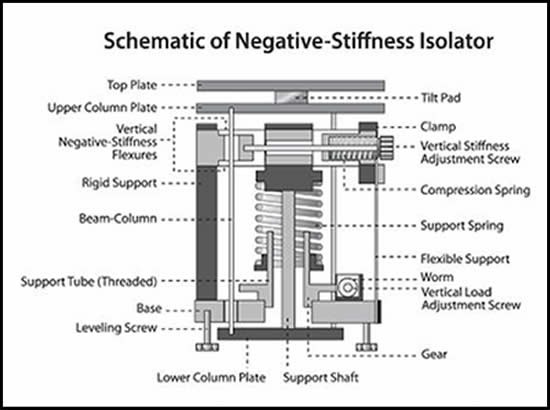
Schematic of a Negative-Stiffness isolator. Image Credit: Minus K Technology
These isolators deliver high-level isolation in multiple directions and can be tailored to achieve resonant frequencies of 0.5 Hz vertically and horizontally. For systems with a 0.5 Hz natural frequency, isolation starts at 0.7 Hz and improves as vibration frequency increases. (Natural frequency is more commonly used to describe system performance.)
Negative-stiffness isolators demonstrate exceptional performance as measured by transmissibility curves. Vibration transmissibility quantifies the vibrations transmitted through the isolator relative to input vibrations. When tuned to 0.5 Hz, negative-stiffness isolators reach around 93 % isolation efficiency at two hertz, 99 % at five hertz, and 99.7 % at 10 hertz.
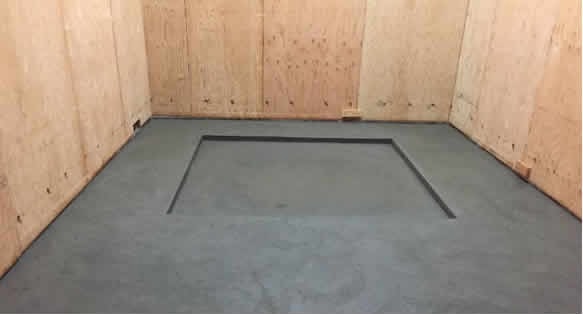
Nion STEM recessed floor. Image Credit: IMRI
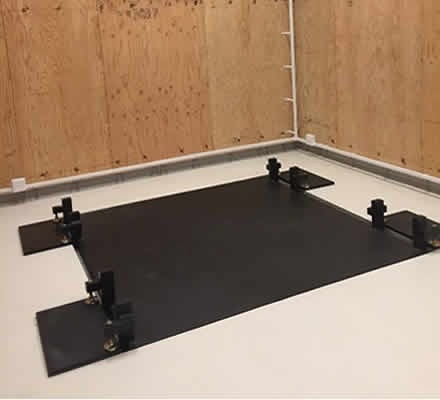
STEM-1 room with a Negative-Stiffness platform flush with the finished floor. Image Credit: IMRI
In June 2018, the inaugural International Symposium on Advanced Electron Microscopy and Spectroscopy was held during the grand opening of the IMRI. During the event, the Nion UltraSTEM 200 HERMES with EELS, supported by Negative-Stiffness vibration isolation, achieved 4.2 meV resolution at 30 keV, setting a new world record.
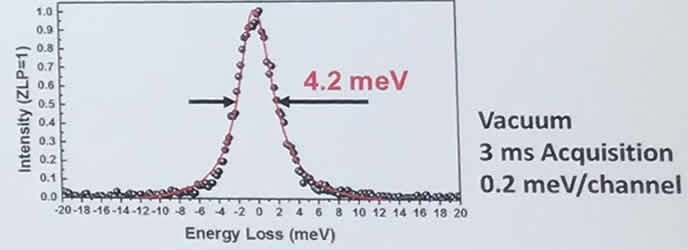
IMRI's UltraSTEM 200 HERMES with EELS and Negative-Stiffness vibration isolation achieved a resolution of 4.2 meV at 30 keV, a new world record. Image Credit: IMRI
Another Research Outcome
One significant outcome of IMRI's study is the development of a novel technique for mapping the direction of thermal carriers in materials.
"It is analogous to counting how many phonons are going up or down and taking the difference, indicating their dominant direction of propagation," said Dr. Pan. "This technique allowed us to map the reflection of phonons from interfaces."
"We found that the SiGe alloy presented a compositionally disordered structure that impeded the efficient propagation of phonons," continued Dr. Pan.
"Because silicon atoms are closer together than germanium atoms in their respective pure structures, the alloy stretches the silicon atoms a bit. Due to this strain, the UCI team discovered that phonons were being softened in the quantum dot due to the strain and alloying effect engineered within the nanostructure."
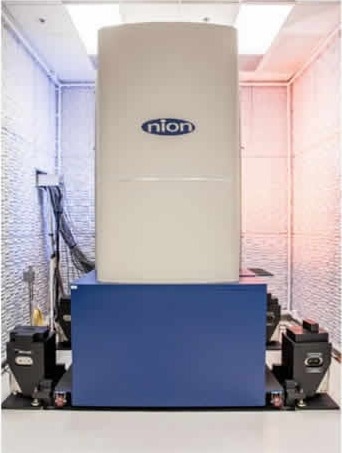
IMRI's Nion UltraSTEM 200 equipped a with high-energy resolution monochromated EELS system and Negative-Stiffness vibration isolation floor platform. Image Credit: IMRI
In addition, softened phonons have reduced energy, suggesting that each phonon carries less heat, thereby lowering thermal conductivity. Vibrational softening represents one of several mechanisms by which thermoelectric devices tend to restrict heat flow.
Developers of thermoelectric technologies endeavor to design materials that either impede thermal transport or promote the flow of charges. Gaining an atom-level knowledge of how heat is transmitted through solids, embedded as they often are with faults, defects, and imperfections, will aid in this quest.
Dr. Ruqian Wu, UCI Professor of Physics and Astronomy
About Irvine Materials Research Institute (IMRI), University of California Irvine (UCI)
The Irvine Materials Research Institute (IMRI) is an interdisciplinary special research program for materials science. As the cross-campus hub for materials research and development, its central mission is to establish UCI as a global leader in materials research.
IMRI operates a broad array of cutting-edge, open-access user facilities for all university, industry, and non-profit researchers for inorganic, organic, and biological materials and device characterization. Its capabilities range from sub-angstrom to macroscopic length scales. Their instrumentation includes transmission electron microscopy (TEM), scanning electron microscopy (SEM), X-ray diffraction (XRD), elemental analysis, and numerous additional methods, along with labs for sample preparation and materials production.
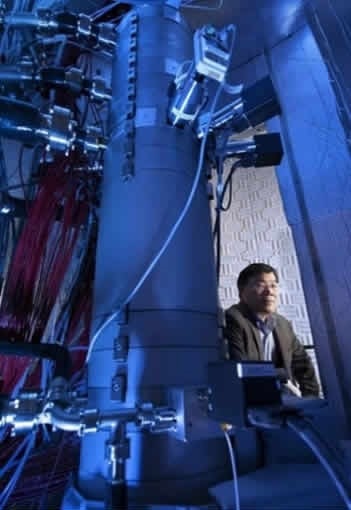
Dr. Xiaoqing Pan, Director of IMRI at UCI, with the lab's Nion UltraSTEM 200 HERMES scanning transmission electron microscope. Image Credit: IMRI
Acknowledgements
Produced from materials originally authored by Steve Varma, President, Minus K Technology.

This information has been sourced, reviewed, and adapted from materials provided by Minus K Technology.
For more information on this source, please visit Minus K Technology.